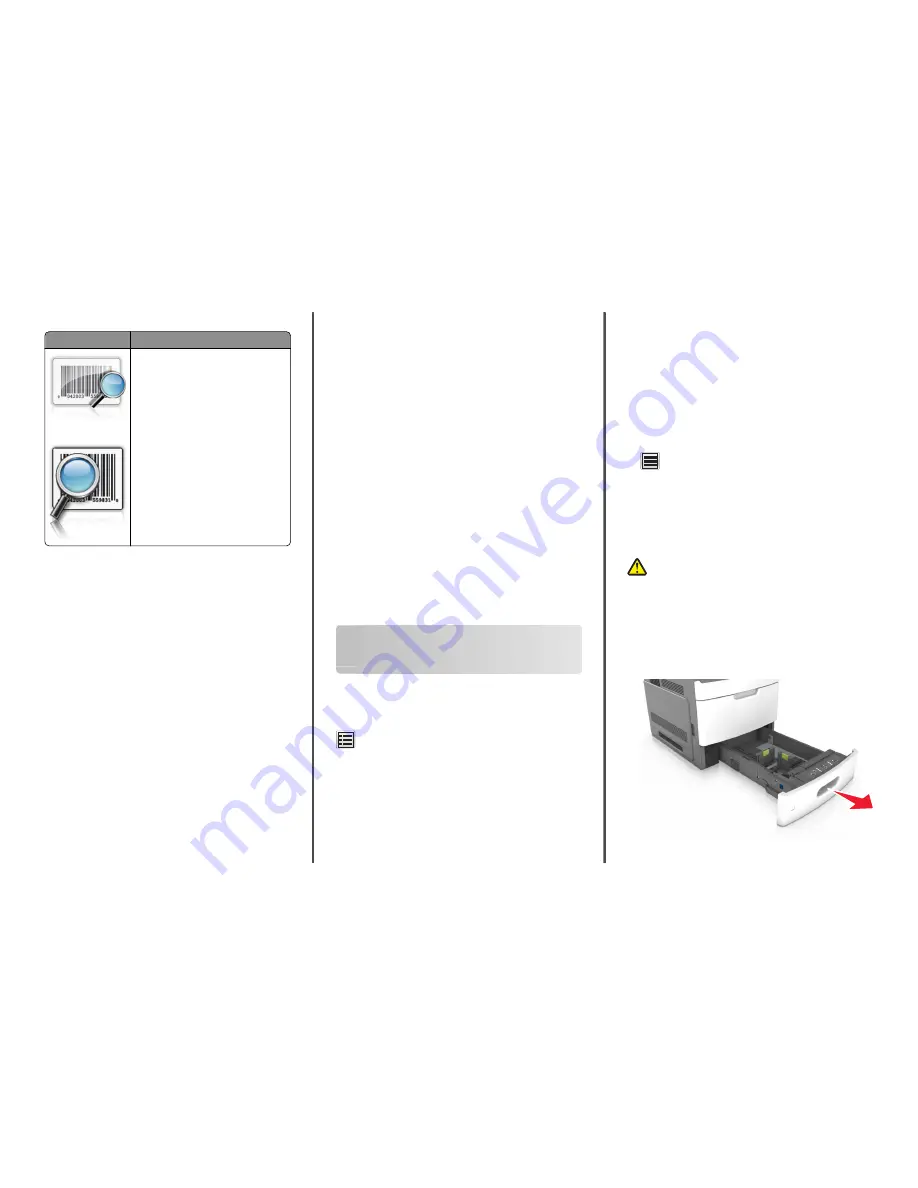
Using Bar Code Discovery
Use
To
or
Create and manage bar code templates to
specify the location and type of bar code that
users will frequently scan.
Note:
Bar Code Discovery can only be
accessed from the scanner home screen.
To use the application, touch
Bar Code Discovery
from the scanner
home screen, and then follow the instructions on the scanner display.
Exporting and importing a configuration
You can export configuration settings into a text file, and then import
the file to apply the settings to other devices.
1
Open a Web browser, and then type the scanner IP address in the
address field.
Note:
View the scanner IP address on the scanner home screen.
The IP address appears as four sets of numbers separated by
periods, such as 123.123.123.123.
2
To export or import a configuration for one application, do the
following:
a
Click
Settings
>
Apps
>
Apps Management
.
b
From the list of installed applications, click the name of the
application you want to configure.
c
Click
Configure
, and then do either of the following:
•
To export a configuration to a file, click
Export
, and then
follow the instructions on the computer screen to save the
configuration file.
Notes:
–
When saving the configuration file, you can type a
unique file name or use the default name.
–
If a "JVM Out of Memory” error occurs, then repeat
the export process until the configuration file is
saved.
•
To import a configuration from a file, click
Import
, and then
browse to the saved configuration file that was exported
from a previously configured device.
Notes:
–
Before importing the configuration file, you can
choose to preview it first or load it directly.
–
If a timeout occurs and a blank screen appears, then
refresh the Web browser, and then click
Apply
.
3
To export or import a configuration for multiple applications, do
the following:
a
Click
Settings
>
Import/Export
.
b
Do either of the following:
•
To export a configuration file, click
Export Embedded
Solutions Settings File
, and then follow the instructions on
the computer screen to save the configuration file.
•
To import a configuration file, do the following:
1
Click
Import Embedded Solutions Settings File
>
Choose File
, and then browse to the saved
configuration file that was exported from a previously
configured device.
2
Click
Submit
.
Loading paper and specialty
media
Setting the paper size and type
From the home screen navigate to:
>
Paper Menu
>
Paper Size/Type
> select a tray > select the paper
size or type >
Submit
Configuring Universal paper settings
Universal paper size is a user
‑
defined setting that lets you print on
paper sizes that are not preset in the printer menus.
Notes:
•
The smallest supported Universal size is
70 x 127 mm (2.76 x 5 inches) for one
‑
sided printing and
105 x 148 mm (4.13 x 5.83 inches) for two
‑
sided (duplex)
printing.
•
The largest supported Universal size is 216 x
356 mm (8.5 x 14 inches) for one
‑
sided and two
‑
sided printing.
•
When printing on paper less than 210 mm (8.3 inches) wide, the
printer may print at a reduced speed after a period of time to
ensure the best print performance.
1
From the home screen, navigate to:
>
Paper Menu
>
Universal Setup
>
Units of Measure
> select
a unit of measure
2
Touch
Portrait Width
or
Portrait Height
.
3
Select the width or height, and then touch
Submit
.
Loading the 550
‑
sheet tray
CAUTION—POTENTIAL INJURY:
To reduce the risk of
equipment instability, load each tray separately. Keep all other
trays closed until needed.
1
Pull out the tray.
Notes:
•
When loading folio
‑
, legal
‑
, or Oficio
‑
size paper, lift the tray
slightly and pull it out completely.
•
Avoid removing trays while a job prints or while
Busy
appears on the scanner display. Doing so may cause a jam.
7






















